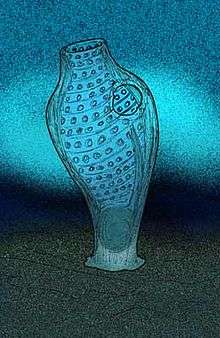Burykhia
| Burykhia Temporal range: 555 Ma | |
|---|---|
 | |
| reconstruction as a tunicate-like animal | |
| Scientific classification | |
| Kingdom: | Animalia |
| Phylum: | Chordata |
| Subphylum: | Tunicata |
| Class: | Ascidiacea (?) |
| Family: | †Ausiidae |
| Genus: | †Burykhia |
Burykhia hunti is a Precambrian fossil genus from the White Sea region of Russia dating to 555 million years ago. It is considered of Ascidian affinity, due to the sac-like morphology and a series of distinctly perforated bands reminiscent of a tunicate pharynx. If B. hunti is a tunicate, it could be the oldest ascidian fossil known as of its publication in 2012.[1] It is possibly related to the slightly younger Ausia, another putative ascidian from the Vendian biota in Namibia.[1] In the case of Burykhia, the narrow longitudinal vessels support affinity with the suborder Phlebobranchia.
Burykhia does not appear to have been colonial.[1]
See Also
References
- 1 2 3 Fedonkin, M. A.; Vickers-Rich, P.; Swalla, B. J.; Trusler, P.; Hall, M. (2012). "A new metazoan from the Vendian of the White Sea, Russia, with possible affinities to the ascidians". Paleontological Journal 46: 1. doi:10.1134/S0031030112010042.
This article is issued from Wikipedia - version of the Saturday, August 29, 2015. The text is available under the Creative Commons Attribution/Share Alike but additional terms may apply for the media files.